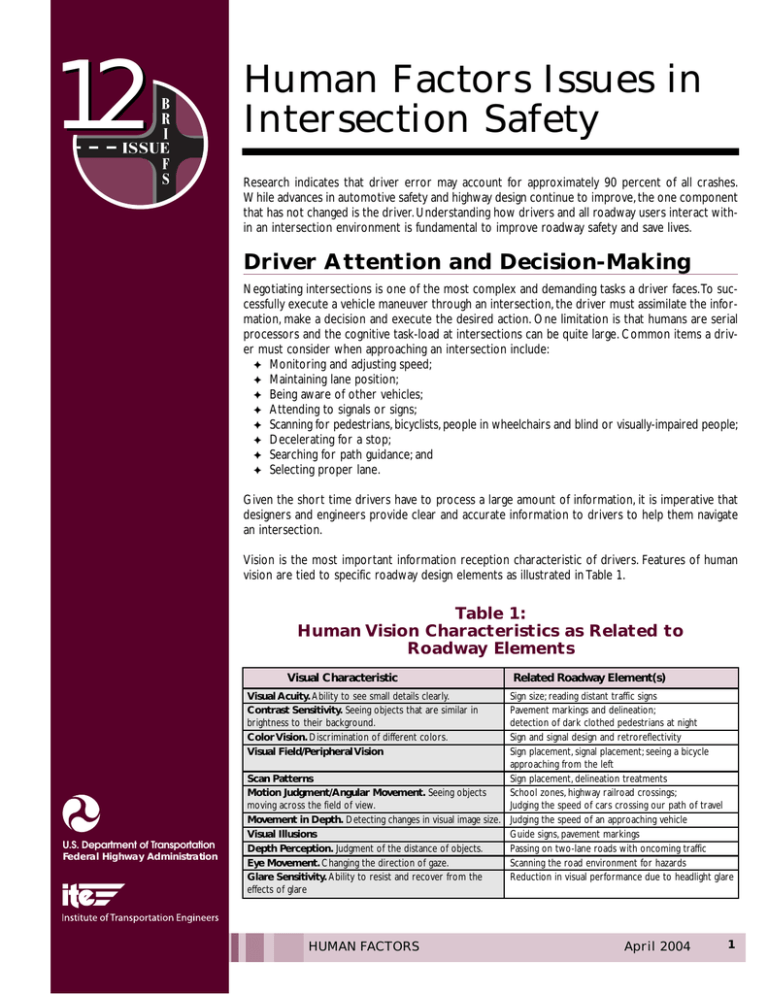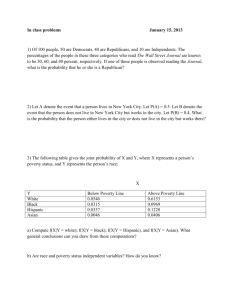12 Human Factors Issues in Intersection Safety
advertisement

12 Human Factors Issues in Intersection Safety Research indicates that driver error may account for approximately 90 percent of all crashes. While advances in automotive safety and highway design continue to improve, the one component that has not changed is the driver. Understanding how drivers and all roadway users interact within an intersection environment is fundamental to improve roadway safety and save lives. Driver Attention and Decision-Making Negotiating intersections is one of the most complex and demanding tasks a driver faces.To successfully execute a vehicle maneuver through an intersection, the driver must assimilate the information, make a decision and execute the desired action. One limitation is that humans are serial processors and the cognitive task-load at intersections can be quite large. Common items a driver must consider when approaching an intersection include: Monitoring and adjusting speed; Maintaining lane position; Being aware of other vehicles; Attending to signals or signs; Scanning for pedestrians, bicyclists, people in wheelchairs and blind or visually-impaired people; Decelerating for a stop; Searching for path guidance; and Selecting proper lane. Given the short time drivers have to process a large amount of information, it is imperative that designers and engineers provide clear and accurate information to drivers to help them navigate an intersection. Vision is the most important information reception characteristic of drivers. Features of human vision are tied to specific roadway design elements as illustrated in Table 1. Table 1: Human Vision Characteristics as Related to Roadway Elements Visual Characteristic Related Roadway Element(s) Visual Acuity. Ability to see small details clearly. Contrast Sensitivity. Seeing objects that are similar in brightness to their background. Color Vision. Discrimination of different colors. Visual Field/Peripheral Vision U.S. Department of Transportation Federal Highway Administration Sign size; reading distant traffic signs Pavement markings and delineation; detection of dark clothed pedestrians at night Sign and signal design and retroreflectivity Sign placement, signal placement; seeing a bicycle approaching from the left Scan Patterns Sign placement, delineation treatments Motion Judgment/Angular Movement. Seeing objects School zones, highway railroad crossings; moving across the field of view. Judging the speed of cars crossing our path of travel Movement in Depth. Detecting changes in visual image size. Judging the speed of an approaching vehicle Visual Illusions Guide signs, pavement markings Depth Perception. Judgment of the distance of objects. Passing on two-lane roads with oncoming traffic Eye Movement. Changing the direction of gaze. Scanning the road environment for hazards Glare Sensitivity. Ability to resist and recover from the Reduction in visual performance due to headlight glare effects of glare HUMAN FACTORS April 2004 1 Human Factors Issues in Intersection Safety Driver Error Perceptual failures account for a large portion of driver errors. These can include such items as “looked but failed to see,” visual obstructions, reduced visibility due to environmental factors, poor judgment of speed and/or distance and low conspicuity of target. However distraction, misinterpretation of information and driver impairment are also major contributing factors. Intersections themselves present their own unique set of driver errors, depending on the type of intersection at hand. Signalized Intersections Common driver errors include: Not understanding whether to proceed or stop at a yellow-signal indication (e.g.This is known as the dilemma zone); Underestimating time to reach an intersection; Underestimating time to make a smooth stop; Failure to detect signal and proper lane assignment; and Misinterpreting guide sign information. Unsignalized Intersections Common driver errors include: Unsafe gap acceptance; Inaccurate estimation of approaching vehicles’ speed; Underestimating time to accelerate after making a turn; and Failure to yield right-of-way. Table 2: Human Factors and Their Relationship to Roadway Design Elements Human Factor Design Value Perception-reaction time 1.0-2.5 sec. Deceleration rate 11.2ft./sec.2 Pre-maneuver. 3.0-9.1 sec. Distance for driver to detect an unexpected condition. Gap acceptance 7.5 sec. Minimum Turning left or right from stop 6.5 sec. Minimum Crossing from stop Driver height of eye 1080 mm Pedestrian walk times 3.0-4.5 fps Engineering Solutions Humans are not perfect when making decisions, and some errors in judgment are inevitable. However, steps can be taken to help reduce the likelihood that driver errors will take place.Therefore, intersection design and features are important and should take the limitations of human performance into account. A signification proportion of intersection crashes involve left-turn maneuvers. Older drivers in particular run the greatest risk of being involved in a leftturn accident, due in part to their diminished ability to judge closure rates of oncoming vehicles. Using alternative intersection designs for left-turn lanes can help alleviate this problem. For example, a positive offset design can Design Element Affected Stopping Sight Distance Stopping Sight Distance Decision Sight Distances Stopping Sight Distance Stopping Sight Distance Stopping Sight Distance Pedestrian Facilities help improve visibility of oncoming vehicles. Adding protected left-turn phases can also assist drivers in turning movements. Other elements of the intersection can be added or modified to improve driver performance and reduce the likelihood of errors. Some include: Using advanced guide signs that are placed in conspicuous locations; Using large pavement markings and scribing path markings for multiple turn lanes; Using larger 12 in. signals or beacons; Using pedestrian refuge islands when possible; Reducing size of dilemma zone with appropriate amber-phase timing or advanced detection; Design Considerations Design policy implicitly incorporates principles of human factors. The “design driver” is assumed by American Association of State Highway Transportation Officials (AASHTO) to be alert and in control of physical and mental abilities; to have a reasonable ability to see and perceive the roadway environment; and to have reasonable motor skills to enable steering, braking and other operations. Table 2 summarizes key human factor considerations and their relationship to design elements. 2 HUMAN FACTORS April 2004 Human Factors Issues in Intersection Safety Ensuring that the intersection is free of visual obstructions; Avoiding permissive right-turnon-red when intersection skew angle is less than 75 degrees; and Ensuring crosswalks are easily visible with high visibility markings and/or beacons. 12 ISSUE BRIEF Training National Highway Institute Course: Human Factors for Transportation Engineers For further information, contact FHWA, Office of Safety, at 202-3668156. This one-day workshop includes interactive modules on information reception, decision-making, driver responses and human factors principles. Upon completion of the course, participants will be able to: Recognize that human factors have a role in highway design, operations and safety decisions; Describe human factors information that is included in today's guidelines and standards; Identify human capabilities needed for using roadways; and Apply basic human factors principles to resolve issues related to highway design, operations and safety. Resources 1. American Association of State Highway and Transportation Officials. A Policy on Geometric Design of Highways and Streets, Fourth Edition. Washington, DC: AASHTO, 2001. 2. Institute of Transportation Engineers. Traffic Engineering Handbook, 5th Edition. Washington, DC: ITE, 1999. HUMAN FACTORS April 2004 3 12 U.S. Department of Transportation Federal Highway Administration HUMAN FACTORS April 2004
